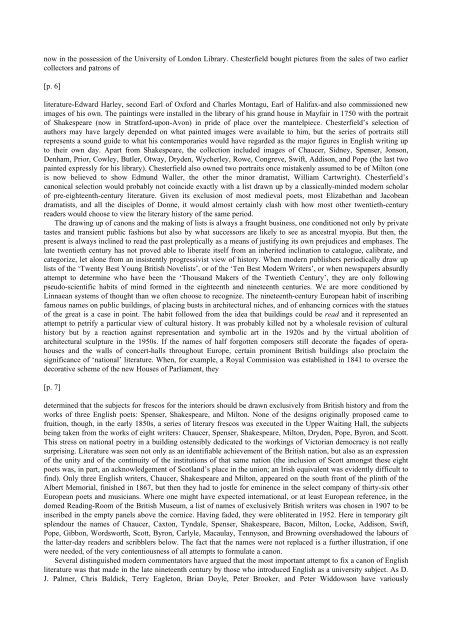THE SHORT OXFORD HISTORY OF ENGLISH LITERATURE
THE SHORT OXFORD HISTORY OF ENGLISH LITERATURE
THE SHORT OXFORD HISTORY OF ENGLISH LITERATURE
Create successful ePaper yourself
Turn your PDF publications into a flip-book with our unique Google optimized e-Paper software.
now in the possession of the University of London Library. Chesterfield bought pictures from the sales of two earlier<br />
collectors and patrons of<br />
[p. 6]<br />
literature-Edward Harley, second Earl of Oxford and Charles Montagu, Earl of Halifax-and also commissioned new<br />
images of his own. The paintings were installed in the library of his grand house in Mayfair in 1750 with the portrait<br />
of Shakespeare (now in Stratford-upon-Avon) in pride of place over the mantelpiece. Chesterfield’s selection of<br />
authors may have largely depended on what painted images were available to him, but the series of portraits still<br />
represents a sound guide to what his contemporaries would have regarded as the major figures in English writing up<br />
to their own day. Apart from Shakespeare, the collection included images of Chaucer, Sidney, Spenser, Jonson,<br />
Denham, Prior, Cowley, Butler, Otway, Dryden, Wycherley, Rowe, Congreve, Swift, Addison, and Pope (the last two<br />
painted expressly for his library). Chesterfield also owned two portraits once mistakenly assumed to be of Milton (one<br />
is now believed to show Edmund Waller, the other the minor dramatist, William Cartwright). Chesterfield’s<br />
canonical selection would probably not coincide exactly with a list drawn up by a classically-minded modern scholar<br />
of pre-eighteenth-century literature. Given its exclusion of most medieval poets, most Elizabethan and Jacobean<br />
dramatists, and all the disciples of Donne, it would almost certainly clash with how most other twentieth-century<br />
readers would choose to view the literary history of the same period.<br />
The drawing up of canons and the making of lists is always a fraught business, one conditioned not only by private<br />
tastes and transient public fashions but also by what successors are likely to see as ancestral myopia. But then, the<br />
present is always inclined to read the past proleptically as a means of justifying its own prejudices and emphases. The<br />
late twentieth century has not proved able to liberate itself from an inherited inclination to catalogue, calibrate, and<br />
categorize, let alone from an insistently progressivist view of history. When modern publishers periodically draw up<br />
lists of the ‘Twenty Best Young British Novelists’, or of the ‘Ten Best Modern Writers’, or when newspapers absurdly<br />
attempt to determine who have been the ‘Thousand Makers of the Twentieth Century’, they are only following<br />
pseudo-scientific habits of mind formed in the eighteenth and nineteenth centuries. We are more conditioned by<br />
Linnaean systems of thought than we often choose to recognize. The nineteenth-century European habit of inscribing<br />
famous names on public buildings, of placing busts in architectural niches, and of enhancing cornices with the statues<br />
of the great is a case in point. The habit followed from the idea that buildings could be read and it represented an<br />
attempt to petrify a particular view of cultural history. It was probably killed not by a wholesale revision of cultural<br />
history but by a reaction against representation and symbolic art in the 1920s and by the virtual abolition of<br />
architectural sculpture in the 1950s. If the names of half forgotten composers still decorate the façades of operahouses<br />
and the walls of concert-halls throughout Europe, certain prominent British buildings also proclaim the<br />
significance of ‘national’ literature. When, for example, a Royal Commission was established in 1841 to oversee the<br />
decorative scheme of the new Houses of Parliament, they<br />
[p. 7]<br />
determined that the subjects for frescos for the interiors should be drawn exclusively from British history and from the<br />
works of three English poets: Spenser, Shakespeare, and Milton. None of the designs originally proposed came to<br />
fruition, though, in the early 1850s, a series of literary frescos was executed in the Upper Waiting Hall, the subjects<br />
being taken from the works of eight writers: Chaucer, Spenser, Shakespeare, Milton, Dryden, Pope, Byron, and Scott.<br />
This stress on national poetry in a building ostensibly dedicated to the workings of Victorian democracy is not really<br />
surprising. Literature was seen not only as an identifiable achievement of the British nation, but also as an expression<br />
of the unity and of the continuity of the institutions of that same nation (the inclusion of Scott amongst these eight<br />
poets was, in part, an acknowledgement of Scotland’s place in the union; an Irish equivalent was evidently difficult to<br />
find). Only three English writers, Chaucer, Shakespeare and Milton, appeared on the south front of the plinth of the<br />
Albert Memorial, finished in 1867, but then they had to jostle for eminence in the select company of thirty-six other<br />
European poets and musicians. Where one might have expected international, or at least European reference, in the<br />
domed Reading-Room of the British Museum, a list of names of exclusively British writers was chosen in 1907 to be<br />
inscribed in the empty panels above the cornice. Having faded, they were obliterated in 1952. Here in temporary gilt<br />
splendour the names of Chaucer, Caxton, Tyndale, Spenser, Shakespeare, Bacon, Milton, Locke, Addison, Swift,<br />
Pope, Gibbon, Wordsworth, Scott, Byron, Carlyle, Macaulay, Tennyson, and Browning overshadowed the labours of<br />
the latter-day readers and scribblers below. The fact that the names were not replaced is a further illustration, if one<br />
were needed, of the very contentiousness of all attempts to formulate a canon.<br />
Several distinguished modern commentators have argued that the most important attempt to fix a canon of English<br />
literature was that made in the late nineteenth century by those who introduced English as a university subject. As D.<br />
J. Palmer, Chris Baldick, Terry Eagleton, Brian Doyle, Peter Brooker, and Peter Widdowson have variously









